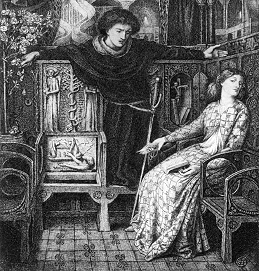 Pen and ink on paper, 12 x 10.5 inches. The British Museum, London.
Pen and ink on paper, 12 x 10.5 inches. The British Museum, London.
 Pen and ink on paper, 12 x 10.5 inches. The British Museum, London.
Pen and ink on paper, 12 x 10.5 inches. The British Museum, London.
In Act III, scene i, Ophelia attempts to return to Hamlet the "remembrances" he has given her. Hamlet kneels on the seat next to her as she extends her hand and turns her face from his harsh words. In an early work (1899) on Rossetti's art, H. C. Marillier immediately makes the connection between this drawing and the contemporary theater; apart from its great wealth of detail and richness of treatment," he says, "this drawing is highly remarkable for its intellectual conception of the character of Hamlet. At a time when there lingered the hideous tradition of nodding plumes and trunk hose, Rossetti has represented the Prince gracefully and gravely attired, with hair tossed back, and such a handsome serious face as Mr. Benson or Mr. Forbes Robertson would offer us to-day" (96). Sir Frank Benson and Sir Johnston Forbes Robertson (something of a matinee-idol) were both noted for their portrayals of Hamlet. What strikes Marillier is that the Rossetti drawing depicts Hamlet as he ought to look, according to what was currently being done on the stage.
Marillier notes a few elements of the picture that seem not to interest him much, but what gives this scene a special resonance and power is Rossetti's masterful attention to those details. On the back of the seat upon which Hamlet rests his right arm is a carving of the Tree of Knowledge guarded by two angels with swords. Placed vertically on either side of the Tree is an inscription, "Eritis sicut deus scientes bonum et malum [You will be as a god, knowing both good and evil]," a slightly altered quotation from Genesis 3:5, where the word is "dii" rather than "deus" ["You will be as gods"]. Wound about the Tree is the serpent, but here he wears a crown, reminding us pointedly of the ghost's words to Hamlet: "But know, thou noble youth, / The serpent that did sting thy father's life / Now wears his crown" (I.v). The Tree is an especially fitting image for Hamlet, whose obsessive purpose in the play is to gain knowledge of his father's death and his uncle's part in it.
The carving of the Tree is on the back of a misere with its seat upturned. On the bottom of the seat is another carving with a scene from the Old Testament. II Samuel 6:6-8 tells the story of Uzzah, who was transporting the Ark of the Covenant for King David. When the oxen stumbled and Uzzah put out his hands to steady the cart, God struck him dead when he touched the Ark. The story of Uzzah seems to support the old adage that no good deed goes unpunished; a typical gloss on the passage says, "Here we see the danger it is to follow good intentions, or to do anything in God's service without his express word." The situation is analogous to Ophelia's, for she believes she is acting in Hamlet's best interests by obeying her father's wishes in his attempt to plumb the cause of Hamlet's distraction. The analogy is all the stronger when we note the similarity in the posture of the arms of Uzzah and Ophelia. Both are the unwitting victims of good intentions.
As Hamlet speaks he absent-mindedly--perhaps nervously--plucks at a rose with his right hand, and the petals fall to the table as he unknowingly destroys these symbolic flowers. His other arm rests on the back of the seat with his palm facing the viewer; his outstretched arms thus duplicate the posture of Christ on the crucifix in the alcove above Ophelia's arm, as deliberate an analogy as that between Uzzah and Ophelia.
The composition of the drawing with its correspondences between Hamlet and Christ and Ophelia and Uzzah thus prefigure a tale of unwitting sacrifice and death yet to come. All these images are further associated with a relentless pursuit of knowledge, represented by the Tree, the books below the crucifix in the alcove, and the book on Ophelia's lap. Like Uzzah, and perhaps even Christ, Hamlet will ultimately give himself up to the inscrutable will of God; Hamlet's fate is to become the "scourge and minister" (III.4) of God and purge the state of Denmark.